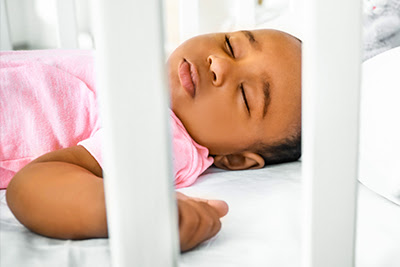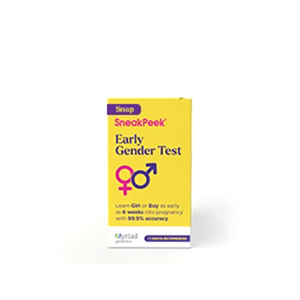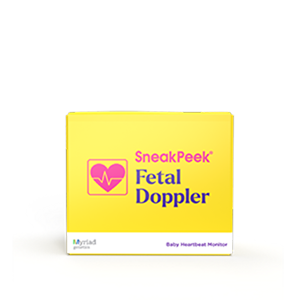Published on May 18th, 2021 and Updated on January 15th, 2024
Check out SneakPeek Gender Test to find out your baby’s gender as early as 6 weeks at over 99% accuracy1!
When it comes to your baby’s favorite sleep places, you know what works and what doesn’t. Snuggled against your chest? Check! The car seat on long drives? Check! The crib? Big X!
Although you and your partner may have picked out your baby’s crib with love and care, your little one may have “mixed feelings” (to put it kindly) about his bassinet or bed. When your baby struggles to sleep in his crib, it can impact his overall sleep health and make it more difficult for him to acclimate to sleep schedules. A few tips and tricks can help turn your baby’s crib into a haven of snoozes so that your little one (and you) can rest easy.
Why won’t my baby sleep in the crib?
Understanding how to get a newborn baby and even a toddler to sleep in cribs starts with learning more about why your little one makes that adorable Not that thing again! face at the crib when it’s nap time or bedtime.
Some reasons babies have a hard time sleeping in cribs:
- Cribs can seem really weird to babies – Infant sleep can be very particular. From the constant hug of the womb to the snug, soft space in your arms, babies have gotten used to a certain kind of sleep style. Compared to warm arms and the cozy womb, cribs might seem like a totally bizarre sleep space to your little one.
- Babies don’t know how to sleep in a crib – When a baby drifts off during a mid-morning snuggle, she is cradled in your warm arms, surrounded by your familiar scent, and maybe even the comforting motion of a rocking chair ushering her to sleep. A crib’s mattress, lack of snuggle companions, and open space might completely befuddle a drowsy baby. Her confused, scrunched–up face might ask, “How the heck am I expected to nap like this, Mom?”
- The crib is too wide for your snuggle-loving baby – When babies fall asleep in a parent’s arms or even in a car seat, they have that sense of being secured and snug in a safe sleep environment. That slight, all-over pressure can actually trigger a physiological response for your baby to relax. It’s like constantly being hugged. The crib isn’t exactly huggable, so it may be more difficult for your baby to relax and drift off in the wide–open space of the crib.
- Your baby can smell your fear… – Well, not really. But babies are as attuned to their parents’ tension as parents are to theirs. Studies show that when a baby sees a parent experiencing stress, the baby will show similar signs of stress, such as elevated heart rate and irritability. If putting your baby down for a nap and leaving her alone for a few hours stresses you out, your baby will sense it, feel it for herself, and struggle to relax and drift off.
- Sudden changes in your baby’s body can make it harder to sleep – Your baby’s body is constantly developing. Sometimes, big changes can disrupt your little one’s sleep pattern, making it hard to settle down in a crib. Those big changes may include:
- Teething pain
- Sickness
- Growth spurts
- Sleep regression
- Your baby might use crib time as playtime – You may notice that with each new developmental milestone comes a struggle to get your baby to snooze in her crib. That’s because these new milestones like babbling, rolling over, or sitting up are so fun for your baby. So fun, in fact, that when left to her own devices, she wants to practice them all night long!
How to Get Your Baby to Sleep in Cribs
If your baby is having sleep problems and is having a hard time settling down and drifting off into peaceful sleep in his crib, that’s okay. There are plenty of ways to encourage him to enjoy crib time.
Set the Scene for Sleep
Babies are extremely sensitive to their environments. Sometimes, a few adjustments to their sleep space might encourage your little one to settle in his crib and enjoy a good long snooze. It’s time for a baby room makeover—extreme sleep edition!
- Change the temperature of the room – What do a parent’s arms and the womb have in common? They’re both warm! If your baby has a hard time falling asleep in a crib, it may be that he’s not used to being without your cozy body heat. However, a room that’s too warm may be uncomfortable for your baby. What does your little Goldilocks need? Experts recommend keeping a baby’s room between 68-72 degrees Fahrenheit.
- Adjust the lighting – In the first few months of life, your baby is still getting used to days of wakefulness and nights of sleep. This sleep cycle of wakefulness and rest is called the circadian rhythm. Light plays an important role in the development of a baby’s circadian rhythm because the blue light in the sun’s rays triggers a chemical response in the brain that tells your baby’s body to stay alert and awake. Keeping your baby’s room as dark as possible with light-blocking curtains may help trigger your baby’s natural sleep systems to kick in.
- Try a white noise machine – A white noise machine does a phenomenal job covering the little sounds of your home while mimicking the ambient soundtrack of the womb, lulling your little one to sleep. But why is your baby so sensitive to the littlest noises? You’ve probably already experienced how even the smallest little click of the doorknob can wake your little one right up. This is actually your baby’s startle reflex at work. A startle reflex is your baby’s sensitivity to things that go bump in the night (even if the bump is just Mom setting down a bottle too loudly). The theory is that this startle reflex is an evolutionary feature that lets your baby alert you when a threat is nearby. This reflex can be a double-edged sword when it comes to a sleeping baby in a crib, he’s still getting used to. A white noise machine will help create a consistent, soothing soundscape and encourage your baby to relax.
- Swaddle your sleeper – While you may find it luxurious to sleep with plenty of space to stretch out, your baby may feel isolated by the wide expanse of his crib. Swaddling your baby before putting him down simulates the warmth and security he felt in his first crib—Mom’s womb. Curious how to get baby to sleep longer? Not only can swaddling calm your baby, but when done correctly, it can also help him sleep longer, promoting a more restful slumber.
- Smell – When it comes to scents, babies can be extremely particular. You might notice that your little one even gets upset when you change laundry detergents! Your baby associates your scent with comfort, safety, and snacks, so much that he may not be able to sleep without it. Try sleeping with his pajamas, sleep sack, or swaddle blanket so that it can absorb your scent. When he wears these pajamas or is swaddled in your familiar smell, this will let him know he’s as safe and secure in his crib as he is in his mother’s arms.
Create A Sleep-Positive Routine
Along with ensuring your baby’s sleep area is a haven for snoozing, you can also make tweaks to your baby’s bedtime routine to help her adjust to the crib (and even like it!).
- Make sure your baby is well fed before sleep time – Your sleep space may be the picture of sweet dreams, but if your baby is hungry, it will be difficult for her to settle down for sleep. A little pre-nap snack consisting of breastfeeding or formula can help your baby relax enough to snuggle up in her crib. There are different strategies for sleep training and how to start sleep training for naps that you can look into.
- Create happy associations with the sleep space – If your baby only spends time in her bedroom for sleeping, she may not have had a chance to make positive associations with the space. During the day, spend some time in the baby’s bedroom feeding her, playing with her, or even just walking around with the windows open, enjoying the sunshine. This will help your baby become more familiar with the space and the crib.
- Playtime before bedtime – If your baby is trying out her mad babbling skills or practicing the fine art of crawling, she may be tempted to let practice time cut into her nap time. Before you start your bedtime routine, give your little explorer plenty of time to play and experiment with her new developmental milestones. Then, when her energy starts to lag, start a familiar bedtime routine so she knows it’s time to wind down.
- Build a soothing bedtime routine – A consistent bedtime routine can signal to your baby that it’s time to sleep. A baby’s bedtime routine can consist of a feeding, a warm bath, a lullaby, some storytime with snuggles, and a kiss goodnight. You can also help your baby relax in the crib by laying her down on her back in the crib, then letting your hand rest on her tummy for a few minutes. This little bit of contact can ease your baby into sleep.
Transition Your Baby From Sleeping Everywhere Else to Sleeping in the Crib
Whether it’s his favorite toys or his favorite silly noise, you know when your child has a strong opinion about something. When it comes to sleep, he may make it very clear he prefers anywhere that isn’t the crib.
In those times, try these tips:
- If your baby only sleeps in the swing, stroller, or car seat, take motion out of the equation to help him get used to the crib. For example, at nap time, put your little one in the car seat but don’t drive anywhere. Pop her in the stroller, but don’t stroll anywhere. It may take a few days, but eventually, your baby will adjust to the lack of motion and be ready to give the crib a try.
- If your baby only sleeps in a carrier or sling, help him get used to his crib by taking advantage of his sleepy moments. When his eyelids start to droop, place him in the crib. You can check on him every few minutes, but let him try to fall asleep on his own. Chances are, he’ll be too tired to put up a fuss and instead will settle in for a good night’s sleep. Do babies dream? Find out when babies start to dream with SneakPeek’s blog.
Overcoming the challenges of getting your baby to sleep in the crib can be a journey filled with patience, understanding, and strategic changes in routines. With this guide’s practical and scientifically-backed advice, you’ll soon transform the crib into a haven of sleep for your little one, creating a healthier sleep environment that will benefit the entire family.
Sources:
- Parenting Science. Can Babies Sense Stress. https://www.parentingscience.com/can-babies-sense-stress.html
- What To Expect. What’s the Right Temperature for Baby? https://www.whattoexpect.com/first-year/baby-care/what-is-right-temperature-for-baby/
- Healthline. Startle Reflex in Babies: How Long Does it Last? https://www.healthline.com/health/parenting/startle-reflex-in-babies

Shop Our Products
SneakPeek aims to provide the most accurate and up-to-date information to help our readers make informed decisions regarding their health before, during, and after pregnancy. This article was written based upon trusted scientific research studies and/or articles. Credible information sources for this article are cited and hyperlinked.





